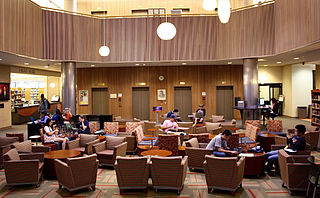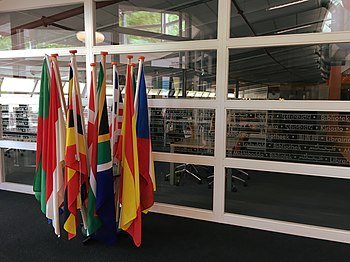Interlibrary loan is a service that enables patrons of one library to borrow physical materials and receive electronic documents that are held by another library. The service expands library patrons' access to resources beyond their local library's holdings, serving as "an integral element of collection development" for libraries.

A consortium is an association of two or more individuals, companies, organizations or governments with the objective of participating in a common activity or pooling their resources for achieving a common goal.

Ephemera are transitory creations which are not meant to be retained or preserved. Its etymological origins extends to Ancient Greece, with the common definition of the word being: "the minor transient documents of everyday life". Ambiguous in nature, various interpretations of ephemera and related items have been contended, including menus, newspapers, postcards, posters, sheet music, stickers and valentines.

OCLC, Inc., doing business as OCLC, is an American nonprofit cooperative organization "that provides shared technology services, original research, and community programs for its membership and the library community at large". It was founded in 1967 as the Ohio College Library Center, then became the Online Computer Library Center as it expanded. In 2017, the name was formally changed to OCLC, Inc. OCLC and thousands of its member libraries cooperatively produce and maintain WorldCat, the largest online public access catalog in the world. OCLC is funded mainly by the fees that libraries pay for the many different services it offers. OCLC also maintains the Dewey Decimal Classification system.

WorldCat is a union catalog that itemizes the collections of tens of thousands of institutions, in many countries, that are current or past members of the OCLC global cooperative. It is operated by OCLC, Inc. Many of the OCLC member libraries collectively maintain WorldCat's database, the world's largest bibliographic database. The database includes other information sources in addition to member library collections. OCLC makes WorldCat itself available free to libraries, but the catalog is the foundation for other subscription OCLC services. WorldCat is used by librarians for cataloging and research and by the general public.
The California Digital Library (CDL) was founded by the University of California in 1997. Under the leadership of then UC President Richard C. Atkinson, the CDL's original mission was to forge a better system for scholarly information management and improved support for teaching and research. In collaboration with the ten University of California Libraries and other partners, CDL assembled one of the world's largest digital research libraries. CDL facilitates the licensing of online materials and develops shared services used throughout the UC system. Building on the foundations of the Melvyl Catalog, CDL has developed one of the largest online library catalogs in the country and works in partnership with the UC campuses to bring the treasures of California's libraries, museums, and cultural heritage organizations to the world. CDL continues to explore how services such as digital curation, scholarly publishing, archiving and preservation support research throughout the information lifecycle.
The National Digital Information Infrastructure and Preservation Program (NDIIPP) of the United States was an archival program led by the Library of Congress to archive and provide access to digital resources. The program convened several working groups, administered grant projects, and disseminated information about digital preservation issues. The U.S. Congress established the program in 2000, and official activity specific to NDIIPP itself wound down between 2016 and 2018. The Library was chosen because of its role as one of the leading providers of high-quality content on the Internet. The Library of Congress has formed a national network of partners dedicated to preserving specific types of digital content that is at risk of loss.

Ann Shumelda Okerson is an American librarian and expert on the licensing of electronic resources and the place of digital technologies in academic and research libraries.
The International Coalition of Library Consortia (ICOLC) is an informal, self-organized group of library consortia from around the world; it exists for strategic and practical discussion of issues of common interest among the consortia members. The ICOLC first met informally as the Consortium of Consortia (COC) in 1997. Over time, its name was adjusted to reflect its increasingly global character.
The Center for Research Libraries is a consortium of North American universities, colleges, and independent research libraries, based on a buy-in concept for membership of the consortia. The consortium acquires and preserves traditional and digital resources for research and teaching and makes them available to member institutions through interlibrary loan and electronic delivery. It also gathers and analyzes data pertaining to the preservation of physical and digital resources, and fosters the sharing of expertise, in order to assist member libraries in maintaining their collections. The Center for Research Libraries was founded in 1949, as the Midwest Inter-Library Center (MILC). The traditional role of CRL was as an aggregator of tangible collection materials, however this has been updated in the digital age into the CRL's current role as a facilitator of collection development, digitization, and licensing collections by individual libraries and interest groups. This transformation required CRL to adopt new funding models from partnerships with key organizations, and an updated use of current technology to support community outreach and engagement. The funding was provided by the Andrew W. Mellon Foundation, the National Science Foundation, and the IMLS.
Digital curation is the selection, preservation, maintenance, collection, and archiving of digital assets. Digital curation establishes, maintains, and adds value to repositories of digital data for present and future use. This is often accomplished by archivists, librarians, scientists, historians, and scholars. Enterprises are starting to use digital curation to improve the quality of information and data within their operational and strategic processes. Successful digital curation will mitigate digital obsolescence, keeping the information accessible to users indefinitely. Digital curation includes digital asset management, data curation, digital preservation, and electronic records management.

HathiTrust Digital Library is a large-scale collaborative repository of digital content from research libraries including content digitized via Google Books and the Internet Archive digitization initiatives, as well as content digitized locally by libraries.
An inventory is the one method that libraries and archives use to determine whether some items in their collection are in need of preservation or conservation activities. A modern inventory might involve examining item by item with a barcode scanner and a laptop, with the objective of adjusting bibliographic and item records in theirs and OCLC's WorldCat databases. Using a laptop and handheld bar code reader will "reduce human error and inconsistencies, while helping to maintain staff concentration and enthusiasm for the project".
A library consortium is any cooperative association of libraries that coordinates resources and/or activities on behalf of its members, whether they are school, public, academic, special libraries, and/or information centers. Consortia exist on a variety of levels, e.g., local, state, regional, national or international. Libraries commonly belong to multiple consortia. The goal of a library consortium is to amplify the capabilities and effectiveness of its member libraries through collective action, including, but not limited to, print or electronic resource sharing, reductions in costs through group purchases of resources, and professional development opportunities. The “bedrock principle upon which consortia operate is that libraries can accomplish more together than alone.”

The University of Texas at San Antonio Libraries (UTSA Libraries) is the academic library of The University of Texas at San Antonio, a state research university in San Antonio, Texas, United States. UTSA Libraries consists of the John Peace Library (JPL) on the Main Campus, the Downtown Library, and the Applied Engineering and Technology (AET) Library. The libraries provide students and faculty with a comprehensive access to information as well as spaces for active learning, teaching, and interdisciplinary scholarship.
Communicative planning is an approach to urban planning that gathers stakeholders and engages them in a process to make decisions together in a manner that respects the positions of all involved. It is also sometimes called collaborative planning among planning practitioners or collaborative planning model.
The Boston Library Consortium (BLC) is a library consortium based in the Boston area with 23 member institutions across New England.
The Ohio State University Libraries are the collective libraries of the Ohio State University and its satellite campuses. This system welcomes Ohio State faculty, students, visiting scholars and the general public to study and research. It includes ten libraries located on the Columbus campus, six libraries on the regional campus of the university and nine special collections. The Ohio State University Libraries offer educational resources and services to support readers to research, learn and teach. They can help researchers find and borrow physical and digital materials from articles, journals, databases, books, dissertations, theses, newspapers, streaming videos and images, etc. The Ohio State University libraries hold over six million volumes in traditional library formats and more in electronic information resources.
The Ontario Council of University Libraries (OCUL) is an academic library consortium of Ontario’s 21 university libraries located in Toronto, Ontario, Canada. Formed in 1967, OCUL member institutions work together to maximize the expertise and resources of their institutions through shared services and projects. OCUL works together in a number of key areas of importance for library services, including collective content purchasing, shared digital infrastructure, external partnerships, and professional development initiatives.
Indigenous librarianship is a distinct field of librarianship that brings Indigenous approaches to areas such as knowledge organization, collection development, library and information services, language and cultural practices, and education. The Encyclopedia of Library and Information Sciences states that Indigenous librarianship emerged as a "distinct field of practice and an arena for international scholarship in the late twentieth century bolstered by a global recognition of the value and vulnerability of Indigenous knowledge systems, and of the right of Indigenous peoples to control them."







